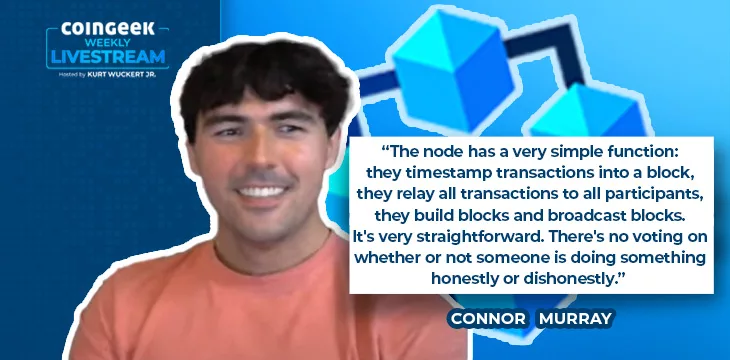
|
Getting your Trinity Audio player ready... |
On the 15th anniversary of the Bitcoin white paper, Connor Murray, CEO and founder of Britevue, joined Kurt Wuckert Jr. on the CoinGeek Weekly Livestream to talk about the last 15 years, the current state of Bitcoin and where it’s headed in the future.
What has Murray been up to?
Wuckert begins by asking Murray what he’s up to these days. Those who have been in BSV blockchain for a while already know he founded Britevue, a Bitcoin-based review platform.
These days, Murray is busy being a father and primarily works with the BSV Blockchain Association and is involved in stewardship over the protocol. Among other things, the Association is involved in defining “rules of engagement” for nodes.
What is an honest node?
Murray says chain splits lead to the mistaken notion that nodes get to vote on what’s valid or invalid. In reality, there has to be one chain to have a real agreement/disagreement about transaction validity.
The white paper is very clear about what nodes should do: timestamp transactions, relay transactions to all participants, and build/broadcast blocks, among other things. They have no say in how the system itself is governed.
Touching briefly on the concept of decentralization at the heart of so much misunderstanding, Murray says it doesn’t exist in the way the term is commonly used. He points out that Satoshi Nakamoto jumped in to fix a few things, and there should be an overseer who makes sure the protocol is stable and who can create beneficial rules.
Is there a way back? How does this play out over the next five years?
Wuckert points out that, as in any civil war, “nobody’s borders are the same as they were before.” This is in reference to the notion that the BSV blockchain is the original Bitcoin, as laid out in the white paper. He wonders if there’s a way back and what this all might look like five years later.
Murray begins with a caveat: his previous predictions don’t have a good track record. He notes that when Bitcoin was created, the idea was that increasing computational power would make it difficult for dishonest actors to gain control. However, we’ve had control for 10 years, and they have lots of computational power.
If these dishonest actors did come in to try to mess up the BSV blockchain, honest nodes could simply ignore them and their blocks, and the honest chain would go on. Even still, Murray says we need to scale as quickly as possible to make the underlying system more valuable than what they have combined.
It has been 15 years since the Bitcoin white paper was released. Is he surprised the BTC camp doesn’t get it or seemingly hasn’t even read it?
Murray says he is less surprised now than he was five years ago. He’s looking at some recent videos related to the Lightning Network, and he can’t understand how they keep going on with it, yet they do.
Wuckert states his view that people should read the white paper and the vast number of Satoshi Nakamoto’s original posts. They’re all out there, and rather than listening to experts telling you what Bitcoin is, it’s much easier to go to the original source.
Murray notes that the white paper is very succinct. There’s a lot that wasn’t laid out before. He finds Nakamoto’s communications with Mike Hearn to be extremely valuable and interesting.
Wuckert says he finds it disheartening that so many ignore Nakamoto’s thoughts and that they don’t have the sort of intellectual curiosity to find out what Bitcoin is and what its inventor said about it.
What’s the most underappreciated section of the Bitcoin white paper?
Murray says it’s section eight on SPV. No wallet has yet engaged the core principle of peer-to-peer payments using Simplified Payment Verification.
Wuckert thinks it’s section five describing nodes and their functions. Amazingly, we can’t even agree on the basic definitions of words.
Now that Lighting has failed, what will BTC Core devs do? What will it mean for BSV blockchain?
These are two paraphrased and combined questions from viewers. Wuckert notes that several Lightning developers have bailed, and the soundbites from Bitcoin are ridiculous.
Murray says he wouldn’t be surprised if they keep trying, but the halving may force the issue. They may increase the block size to two or four megabytes.
What does it all mean for BSV blockchain? Will there be increased demand? Murray doesn’t think the digital currency industry will care about the BSV blockchain in any case. He points out that no blockchain has captured real-world value yet, and he says we need better developer tooling to help with that.
To hear more about what Murray has been up to, the benefits of homomorphic encryption, whether Teranode will change the base protocol, and Dr. Wright’s court cases, tune into the weekly live stream via this link.
Watch: The role of Bitcoin in Web3 and future protocol of IPv6

 11-22-2024
11-22-2024


